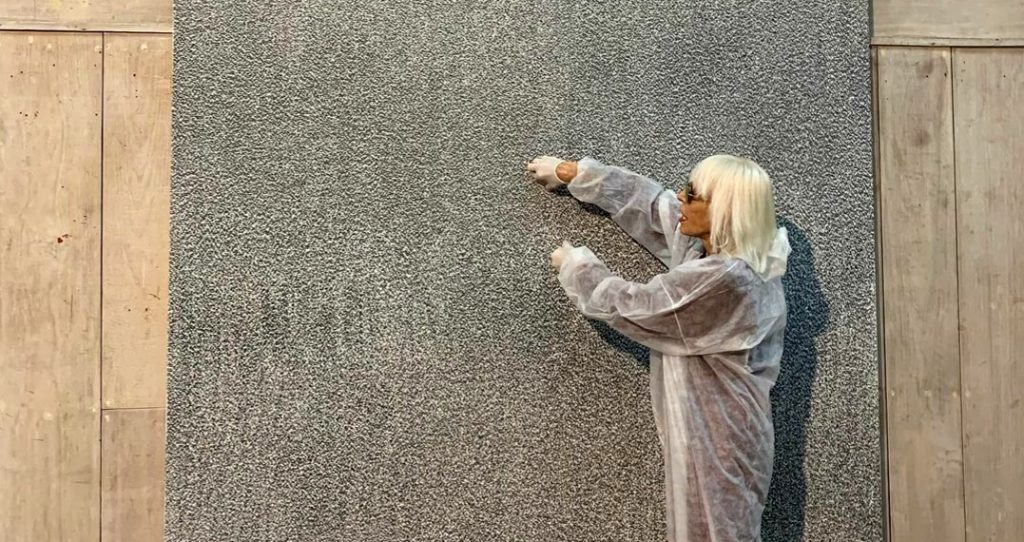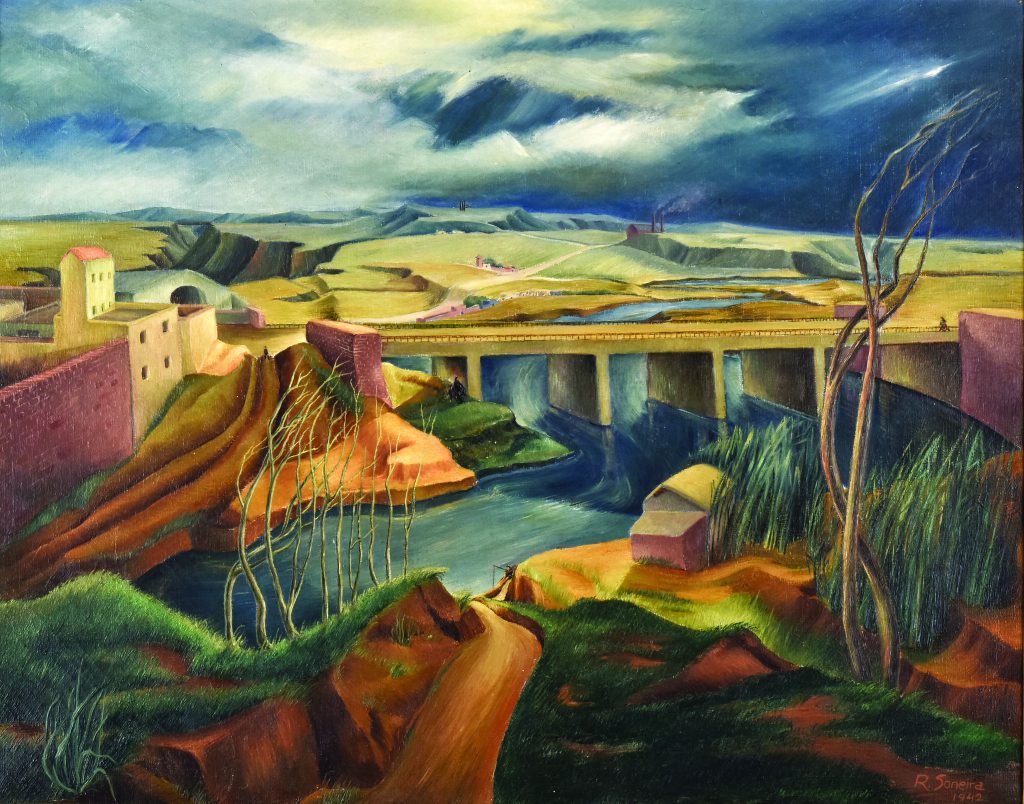El Museo Nacional de Bellas Artes abre hoy al público las exhibiciones temporarias “El canon accidental. Mujeres artistas en Argentina (1890-1950)”, con obras inéditas de creadoras marginadas de la historia del arte; “Ferrari infinito”, una selección de piezas gráficas de León Ferrari de las décadas de 1970 y 1980; y “Pandemia”, la última creación de Marta Minujín, realizada durante el período del aislamiento.
Además, reabren las salas del primer piso del Museo, que albergan la colección permanente dedicada a artistas argentinos e internacionales del siglo XX. De esta manera, junto con las salas de la planta baja ya habilitadas, se completa el recorrido por todo el edificio.
En el reducido acto de inauguración para autoridades y personalidades de la cultura, el director del Bellas Artes, Andrés Duprat, se refirió a “Pandemia” y sostuvo: “Es una obra estupenda y de largo aliento que Marta Minujín fue haciendo en once meses de esto tan extraño que nos toca vivir. Para nosotros, es un honor que ella haya querido presentarla en nuestro Museo, y la exhibimos en el hall, un lugar privilegiado, para que pueda verla incluso la gente que pasa por la vereda”.
Los artistas Luis Felipe Noé, Diana Dowek y Graciela Taquini; el presidente de la Asociación Amigos del Museo Nacional de Bellas Artes, César Crivelli; las investigadoras Laura Malosetti Costa y Cecilia Rabossi; el ministro de Cultura de la Ciudad de Buenos Aires, Enrique Avogadro; el subsecretario de Políticas Culturales de la Provincia de Buenos Aires, Ezequiel Grimson; la embajadora de Francia, Claudia Scherer-Effosse; su par italiano, Giuseppe Manzo; Donatella Canova, directora del Instituto de Cultura Italiano, además de familia e integrantes de la Fundación Augusto y León Ferrari Arte y Acervo (FALFAA), fueron algunos de los presentes.

Al tomar la palabra, Minujín comentó: “Espero que todos puedan ver y disfrutar una obra que solamente pude haber hecho en tiempos de pandemia, porque era un año de aislamiento, y la única energía que podía recuperar en ese aislamiento era hacer esta obra. Entonces, pensé que era una obra para todos, porque todos vivimos lo mismo. Esos puntos blancos y negros simbolizan a todos nosotros, y cómo el mundo cambió”.
El ministro de Cultura de la Nación, Tristán Bauer, afirmó: “Es un honor tener a Marta Minujín aquí, que esté tu obra aquí expuesta. Nos hablaste de estos tiempos difíciles, de la muerte, del sufrimiento, de la enfermedad, y siempre el arte ha sido reflejo de esos tiempos. Nos honra tu presencia y que al ingresar al Museo esté ahí, para ser compartida por todos y todas, esta obra tan imponente y al mismo tiempo bella, que has realizado en tiempos de pandemia”.
En referencia a la muestra sobre Ferrari, curada por Carolina Jozami, Duprat precisó que todas las obras exhibidas fueron donadas al Bellas Artes por la Fundación Augusto y León Ferrari Arte y Acervo (FALFAA). “León Ferrari había hecho una donación importante a nuestro Museo en 2004, y ahora la Fundación repite el gesto, así que estamos muy contentos. Como estas obras pertenecen a todos los argentinos, nos da mucho placer que el público pueda conocerlas”.
Al hablar de “El canon accidental”, curada por Georgina Gluzman, el director del Museo sostuvo: “Es una muestra extraordinaria, producto de una investigación rigurosa sobre el rol de las mujeres artistas a fines del siglo XIX y hasta mitad del siglo XX, que mira con ojos críticos la historia del arte argentino y la propia historia del Museo. La mitad de las obras exhibidas pertenecen a nuestro acervo. Algunas ya se han mostrado, pero otras se verán por primera vez, y ese fue el trabajo de la curadora: sacar a la luz artistas y obras que fueron soslayadas por una mirada absolutamente masculina de la historia del arte”.

Por su parte, Gluzman contó que se trata de una exposición que empezó a soñar hace muchos años junto con la directora artística del Bellas Artes, Mariana Marchesi, y la investigadora Laura Malosetti Costa. “Presenta una historia posible del arte argentino, contada desde los márgenes. Siempre las historias se escriben desde el presente, nuestro presente nos reclama visiones diferenciadas e inclusivas, que pongan en cuestión ciertos dogmas, y la exposición juega con eso: finalmente, lo que aceptamos como canónico podría haber sido de otra manera, podría haber sido un accidente”, explicó.
En alusión a esta muestra sobre mujeres artistas, la secretaria de Patrimonio y Museos, Valeria González, aseveró: “La estructura patriarcal de nuestro patrimonio no solamente tiene que ver con el escaso número de obras de mujeres, sino que las más de las veces estas escasas obras están sujetas a regímenes de invisibilidad. Traer a la luz este patrimonio es fundamental”.
Sobre el cierre del acto, Bauer expresó: “Hemos aprendido en pandemia el rol fundamental que tiene el arte para la humanidad. Cuán importante ha sido, en estos tiempos de encierro, la música, la poesía, la pintura, las distintas disciplinas. Desde el Ministerio de Cultura de la Nación sabemos todos que en el mundo entero y en la Argentina la pandemia ha golpeado particularmente en las distintas industrias culturales, pero las inversiones que venimos desarrollando las vamos a sostener y a poner todos nuestros esfuerzos para mantener la llama de la cultura encendida”.
Las nuevas exposiciones temporarias
Con curaduría de Georgina Gluzman, “El canon accidental” reúne en las salas 37 a 40 más de 80 obras realizadas por 44 artistas, con la intención de cuestionar los relatos establecidos en la historia del arte en nuestro país y recuperar la figura de estas creadoras, muchas de ellas ignoradas o desconocidas.
Integrada por obras del acervo del Bellas Artes, museos provinciales y municipales y colecciones particulares, esta muestra –inédita en la historia del Museo– permite apreciar pinturas, dibujos, grabados, fotografías y esculturas de artistas que, en algunos casos, serán exhibidas por primera vez.
La nómina completa de creadoras participantes está integrada por Graham Allardice de Witt, Carolina Álvarez Prado, Hermi Baglietto, Eugenia Belin Sarmiento, Hortensia Berdier, Emilia Bertolé, Paulina Blinder, Gertrudis Chale, Lía Correa Morales, Josefa Díaz y Clucellas, Ludmila Feodorovna, Raquel Forner, Consuelo Remedios González, Annemarie Heinrich, María de las Mercedes Lacoste, Mariette Lydis, Cecilia Marcovich, Léonie Matthis, Andrée Moch, Ana María Moncalvo, Eloísa Graciana Morás, Laura Mulhall Girondo, María Obligado, María Catalina, Otero Lamas, Anita Payró, Hildara Pérez, Clelia Pissarro, María Carmen Portela, Sofía Posadas, Kettie Ross-Broglia, Hemilce Saforcada, Clorinda Sanna, Rosalía Soneira, Carlota Stein, Leonor Terry, Dora de la Torre, Aída Vaisman, Antonia Ventura y Verazzi, Ángela Adela Vezzetti, Elba Villafañe, María Washington, Ana Weiss, Julia Wernicke y Bibí Zogbé.
“Ferrari infinito”, en tanto, se presenta en el marco de las actividades que el Bellas Artes realiza por el centenario de nacimiento de León Ferrari. Con curaduría de Carolina Jozami, la exposición presenta producciones de las décadas del 70 y 80, que dan cuenta de la experimentación del artista con diversas técnicas gráficas, como la litografía, la xerografía, el aguafuerte y el arte postal. Todas las obras fueron donadas a la colección del Bellas Artes por la Fundación Augusto y León Ferrari Arte y Acervo (FALFAA).
“Pandemia” es la producción que Minujín emprendió en mayo de 2020. Para realizarla, la artista aplicó miles de tiras con pequeños cuadrados en blanco, negro y siete tonos de gris sobre una tela que supera los dos metros de alto y de ancho. La obra se completa con la proyección sobre el bastidor de una imagen de la misma trama. Como complemento y contexto, se exhibe un registro audiovisual sobre la realización de la obra y contenidos en video que Minujín compartió en sus redes sociales durante el proceso.
El Museo Nacional de Bellas Artes, que depende del Ministerio de Cultura de la Nación y cuenta con el apoyo de Amigos del Bellas Artes, puede visitarse de jueves a domingo, de 12 a 19, con entrada gratuita. Para reservar turnos y conocer el protocolo sanitario vigente, hay que ingresar a http://www.bellasartes.gob.ar.


